设置 PowerPoint 演示模板
PowerPoint® 模板指定演示文稿中幻灯片的固定内容和默认布局和外观。当您使用 PPT API 创建演示文稿时,您可以指定要使用的模板。模板可以是空的,也可以有幻灯片。模板中的任何内容都会出现在新演示文稿中。如果您未指定模板,PPT API 将使用默认模板。
您指定的模板可以是:
PPT API 默认模板的自定义副本。
现有的演示文稿。
您在 PowerPoint 中设置的模板。
要自定义默认模板的副本或要用作模板的现有演示文稿,可以使用 PPT API 或 PowerPoint。要添加或自定义幻灯片布局,请使用 PowerPoint。
指定模板
要指定模板,请在创建 mlreportgen.ppt.Presentation 对象时提供模板名称作为第二个参量。例如,此代码指定模板 myTemplate.pptx。
import mlreportgen.ppt.* ppt = Presentation("myPresentation.pptx","myTemplate.pptx");
要使用 PPT API 默认模板,请省略第二个参量。例如:
import mlreportgen.ppt.* ppt = Presentation("myPresentation.pptx");
复制默认模板
要复制 PPT API 默认模板,请使用 mlreportgen.ppt.Presentation.createTemplate。例如:
templatePath = mlreportgen.ppt.Presentation.createTemplate("myTemplate.pptx");使用 PPT API 自定义模板
要自定义默认 PPT API 模板的副本或要用作模板的现有演示文稿:
创建一个
Presentation对象并为演示参量和模板参量指定模板。更新模板,使其包含您想要的幻灯片和模板内容。例如,添加幻灯片。
要保存模板,请关闭
Presentation对象。
例如,此代码创建默认模板的副本,向模板添加标题幻灯片,替换幻灯片标题,并指定标题为红色:
mlreportgen.ppt.Presentation.createTemplate(templateName); import mlreportgen.ppt.* templateName = "myTemplate.pptx"; ppt1 = Presentation(templateName,templateName); open(ppt1); slide = add(ppt1,"Title Slide"); title = Paragraph("My Title"); title.Style = [title.Style {FontColor("red")}]; replace(slide,"Title",title); close(ppt1); rptview(ppt1);
当您使用 myTemplate.pptx 作为模板创建演示文稿时,演示文稿会有一个标题幻灯片,其标题为红色的 My Title。
要自定义要使用模板的现有演示文稿,请使用与自定义默认模板副本相同的步骤。例如,此代码创建一个名为 myPresentation.pptx 的演示文稿,该演示文稿有一张幻灯片,然后通过替换幻灯片标题并将标题文本变为红色来自定义 myPresentation.pptx。
import mlreportgen.ppt.* presName = "myPresentation.pptx"; ppt2 = Presentation(presName); open(ppt2); slide = add(ppt2,"Title Slide"); close(ppt2); ppt3 = Presentation(presName,presName); open(ppt3); slide = ppt3.Children(1); title = Paragraph("My Title"); title.Style = [title.Style {FontColor("red")}]; replace(slide,"Title",title); close(ppt3); rptview(ppt3);
当您使用 myPresentation.pptx 作为模板创建演示文稿时,演示文稿会有一个标题幻灯片,其标题为红色的 My Title。
在 PowerPoint 中以交互方式自定义模板
使用 PowerPoint 进行以下模板自定义:
指定演示文稿的默认格式
要指定在整个演示文稿中应用的格式,请使用幻灯片母版。幻灯片母版中的格式是其所有子幻灯片布局的默认格式。
在 PowerPoint 中,打开一个模板或您想要用作模板的演示文稿。
在视图选项卡的母版视图部分中,点击幻灯片母版。例如使用默认的 PPT API 模板:
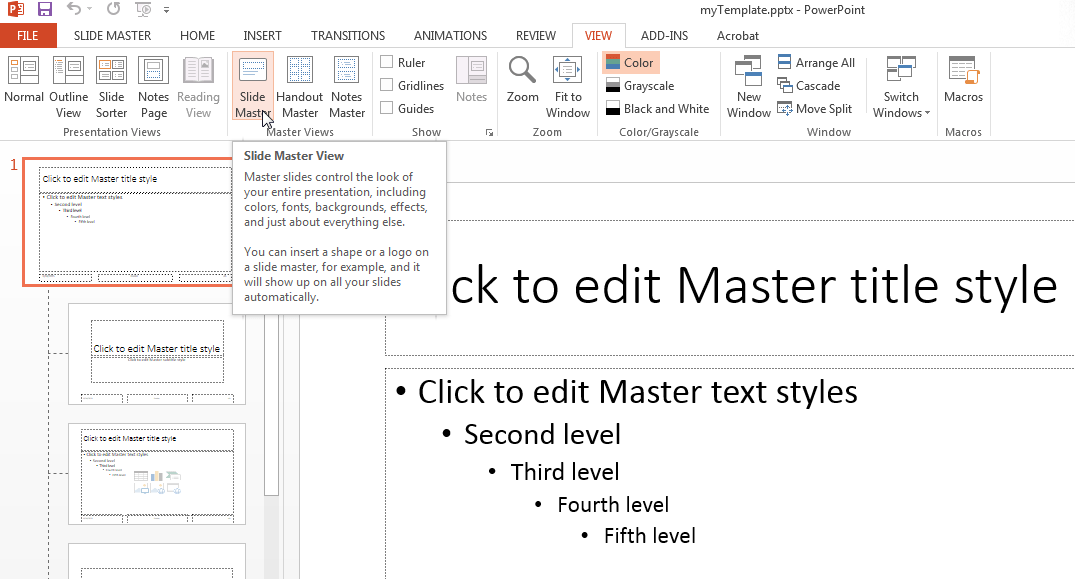
在幻灯片母版中,点击占位符。例如,在主标题幻灯片中,点击点击以编辑 Master 标题样式文本并选择格式选项,例如将字体颜色更改为红色。
保存模板。
添加幻灯片母版
您可以将幻灯片母版添加到 PowerPoint 模板。添加幻灯片母版对于为演示文稿的不同部分提供不同的格式很有用。
在 PowerPoint 中打开模板。
在视图选项卡的母版视图部分中,点击幻灯片母版。
在幻灯片母版和布局窗格中,点击最后一张幻灯片布局后。
右键点击并选择插入幻灯片母版。出现一个新的幻灯片母版,其下方有幻灯片布局的副本。

设置新幻灯片母版的格式。
为幻灯片母版赋予一个有意义的名字。默认情况下,PowerPoint 将新母版命名为
Custom Design、1_Custom Design、2_Custom Design等等。在幻灯片母版选项卡的编辑母版部分中,点击重命名并按照提示进行操作。保存模板。
格式化幻灯片布局
要指定应用于特定类型幻灯片的格式,请使用幻灯片布局。
在 PowerPoint 中打开模板。
在视图选项卡的母版视图部分中,点击幻灯片母版。
从幻灯片母版和布局窗格中,选择要更改格式的幻灯片布局。例如,在 PPT API 默认模板中,点击标题和内容幻灯片布局。
提示
要查看幻灯片布局的名称,请指向该布局。出现一个工具提示,其中包含幻灯片布局的名称以及使用该布局的幻灯片数量。
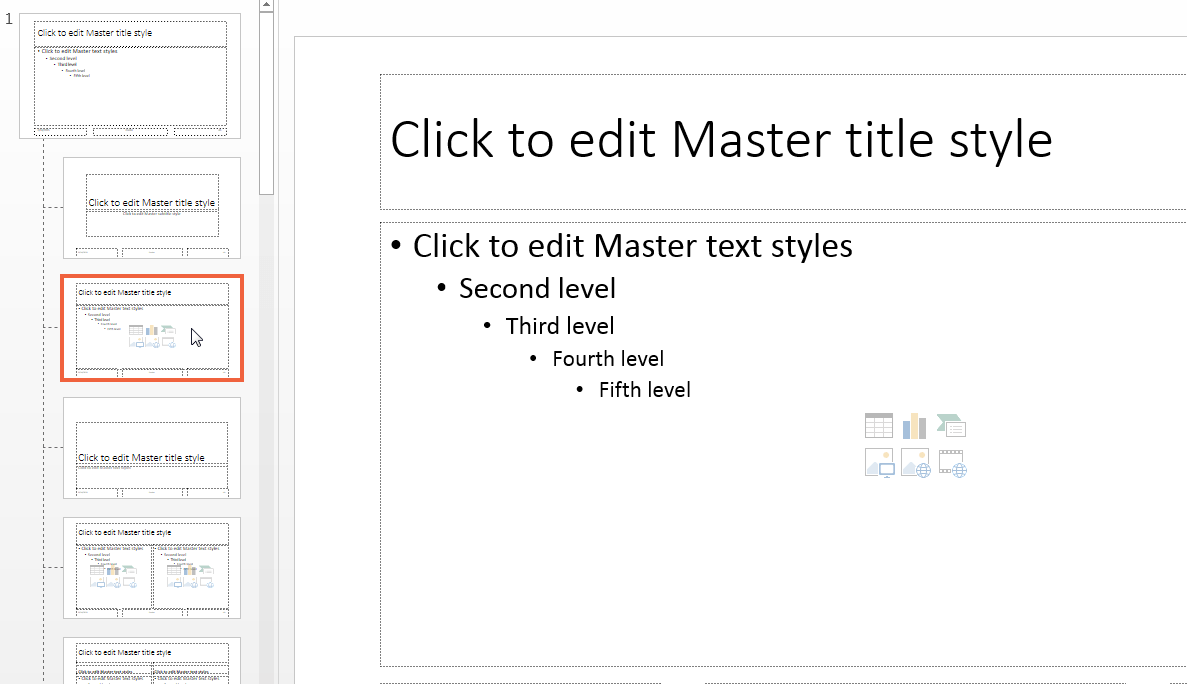
在幻灯片母版中,点击要更改格式的占位符。例如,在默认的 PPT API 模板中,在标题和内容幻灯片布局中,点击点击以编辑 Master 标题样式。选择格式选项,例如将字体颜色更改为红色。此更改适用于该幻灯片布局的标题,但不适用于其他幻灯片布局的标题。
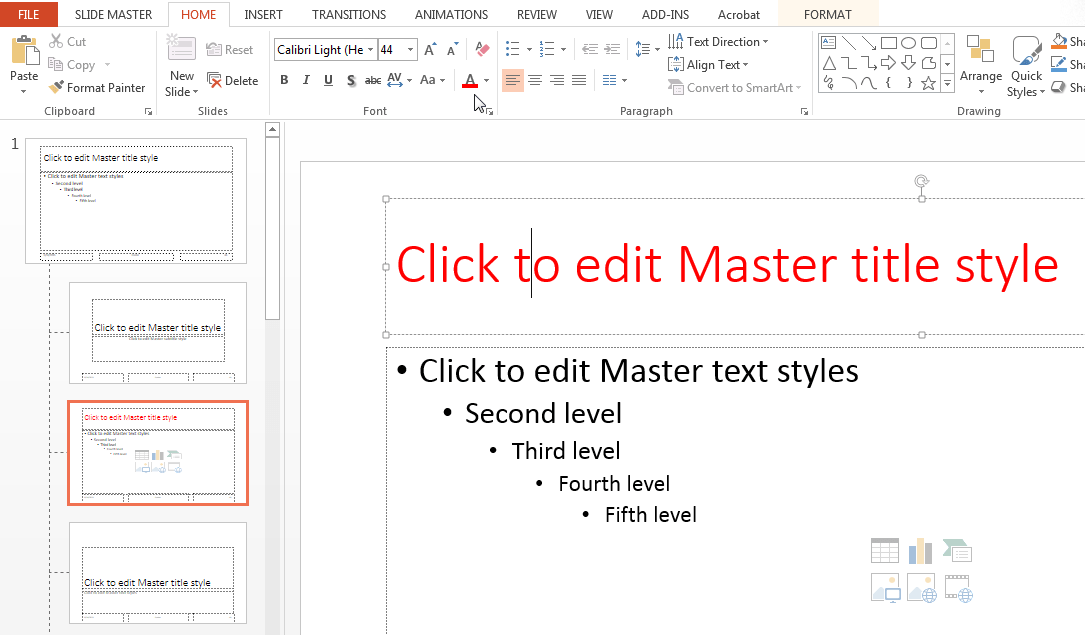
保存模板。
添加幻灯片布局
您可以将幻灯片布局添加到 PowerPoint 模板。
在 PowerPoint 中打开模板。
在视图选项卡的母版视图部分中,点击幻灯片母版。
在幻灯片布局中,右键点击并选择 Insert 样式。出现一个带有标题占位符的新幻灯片布局。
提示
要根据现有幻灯片版式创建幻灯片版式,右键点击要作为版式基础的幻灯片版式。然后选择 Duplicate 样式。
自定义布局。例如,您可以更改现有占位符的字体或添加占位符,例如表占位符。您可以交互地设置表占位符的位置和大小。要删除或添加标题和页脚,请使用幻灯片母版选项卡中的标题和页脚复选框。
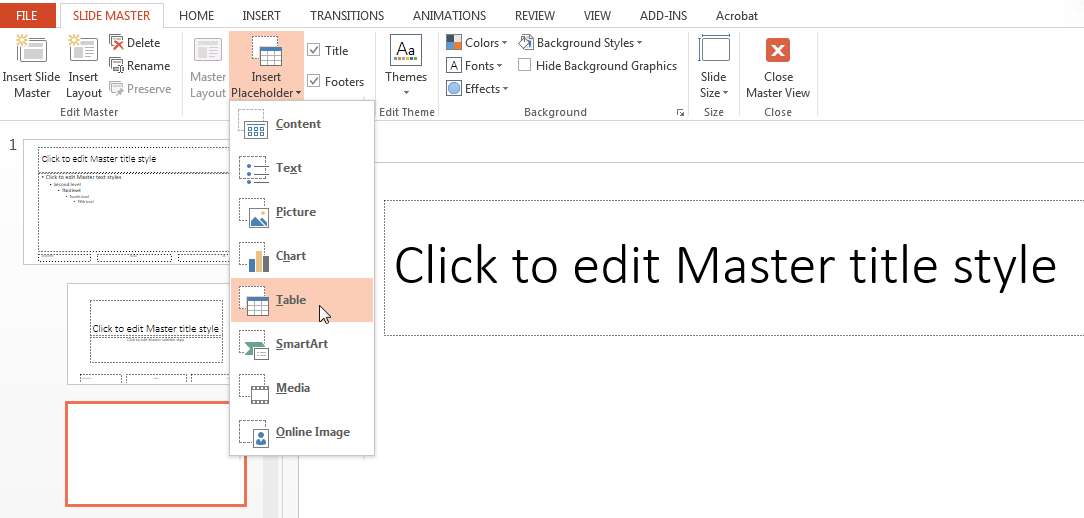
为幻灯片布局赋予一个有意义的名称。(默认情况下,PowerPoint 将新布局命名为
Custom Layout、1_Custom Layout、2_Custom Layout等等。)在幻灯片母版选项卡的编辑母版部分中,点击重命名并按照提示进行操作。保存模板。
向幻灯片布局添加占位符
您可以向任何幻灯片布局添加任何类型的占位符。但是,使用 PPT API,您可以替换此占位符子集:
ContentTextPictureTable
在 PowerPoint 中打开模板。
在视图选项卡的母版视图部分中,点击幻灯片母版。
在幻灯片布局窗格中,选择要添加占位符的幻灯片布局。
在幻灯片母版选项卡的母版样式部分中,点击插入占位符并从列表中选择占位符的类型。例如,在默认的 PPT API 模板中,向空白幻灯片布局添加表占位符。

在幻灯片布局中,调整占位符的大小和位置。
命名使用 PPT API 添加或替换内容时要使用的占位符。要命名占位符,首先显示所选内容窗格。在主页选项卡的编辑部分中,选择 选择 > 选择窗格。在所选内容窗格中,点击占位符名称并键入新的名称。
在幻灯片母版选项卡的关闭部分中,点击关闭母版视图。
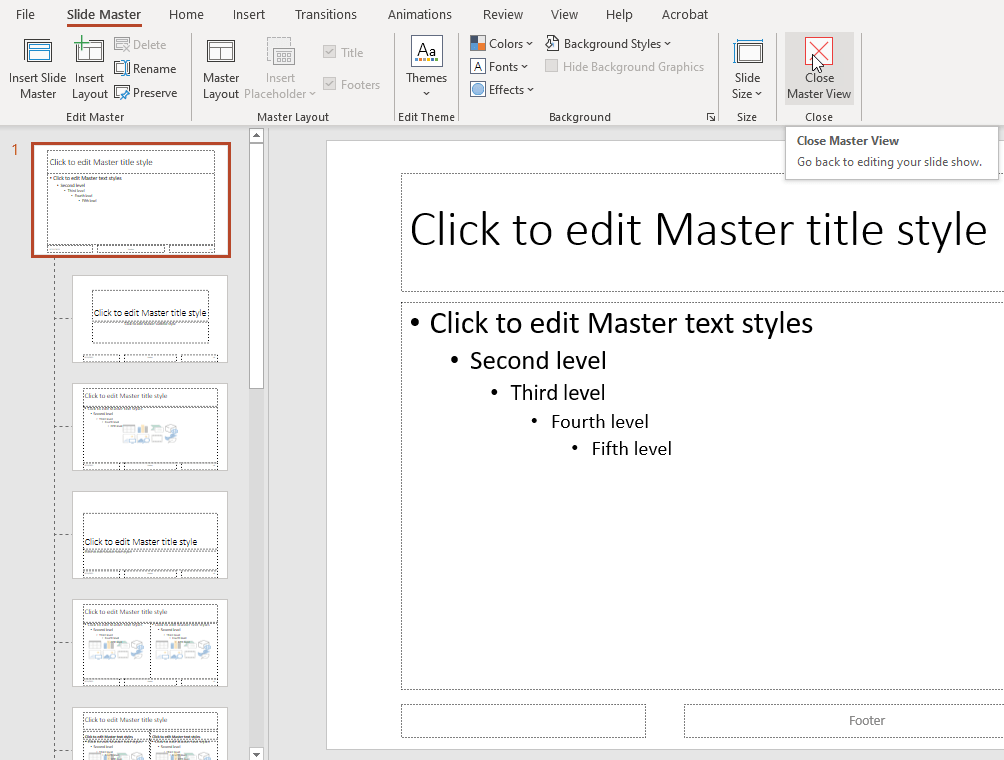
保存模板。